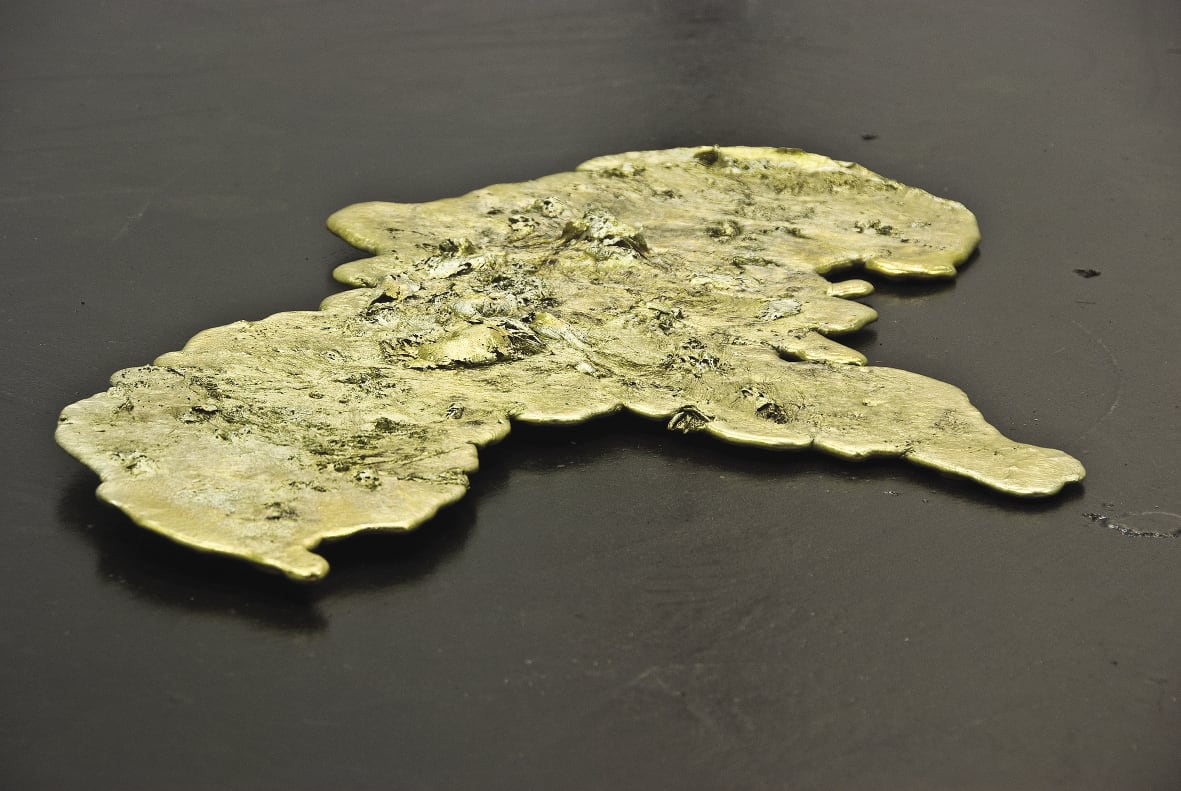Margaret Lawrence Gallery, VCA, Melbourne
10 March – 9 April 2011
curated by Matthew Shannon
The spectre of late 1960s art haunts Margaret Seaworthy Gothic — from the exhibition’s title, sourced from the font designed in 1968 by New York artist Lawrence Weiner, to curator Matthew Shannon’s accompanying text, which positions the exhibition in relation to the history of conceptual art, to the bundle of references (direct and indirect) to key works by Linda Benglis, Marcel Broodthaers, Bruce Nauman, Robert Smithson, as well as the patriarch of conceptual art, Marcel Duchamp. This unusually high ratio of art historical baggage to artworks on display forces one to view the exhibition in relation to this specific historical moment.
In response to the perceived constrictions of the traditional autonomous object, a defining aspiration of first-generation conceptual art was to incorporate the institutional frame into the structure of the work itself. One such strategy, enabled by a re-reading of Duchamp, was the introduction of the non-art object into the gallery as a way to disrupt established definitions of the acceptable boundaries of art, calling into question the gallery or museum’s role as gatekeeper.
Retrospectively revisiting certain works from this era can be strange: while many continue to stubbornly resist traditional aesthetic ideals, they also now appear to us as part of an accepted art historical narrative. A sedimentation of a succession of art-historical studies, themed survey blockbusters, and the emergence of post- and neo-conceptualisms have all contributed to altering our perception of the so-called first-wave of conceptual art. For the success of an exhibition like Margaret Seaworthy Gothic — which seeks so deliberately to align itself with the history of conceptual art — it is essential that it recognises this history as dynamic and therefore susceptible to perpetual transformation.
One carefully considered response to the cult status garnered by certain canonical art objects is provided by Colin Duncan. Made of black, brittle plastic, his Shadow works from 2006 render the silhouettes of three instantly recognisable artworks: Duchamp’s In Advance of a Broken Arm 1915, Constantin Brancusi’s Endless Columns 1918 and Smithson’s Spiral Jetty 1970. Refusing to offer much in the way of visual satisfaction (qualifying as ‘anti-retinal’ in Duchamp’s terms), Duncan’s works instead function as mnemonic triggers, reliant on the now-iconic status of the depicted works. The viewer projects associations conjured by the absent classic work onto the flattened, monochrome replica, which functions as a platform for a series of mute dialogues across history.
The presence of the Duchampian readymade also lurks behind Andrew Liversidge’s FOR THE AVOIDANCE OF DOUBT (QUID PRO QUO AND THE GOLDEN TORPOR) 2011, which consists of the the residues of a pathetic alchemical procedure. Liversidge melts his artist’s fee (in the form of one thousand dollar coins) into a globular mass. Presented in its solid state on the gallery floor, the work insists upon the materiality of currency in a way that disables its normal use. Matthew Shannon’s contribution, a photocopied book in the vein of a graphic comic, dramatises the misleadingly negative space of the gallery wall against which, it is implied, values are culturally determined. The narrative consists of a pseudo-philosophical conversation between a man and the paint on the gallery wall, in which the latter takes the opportunity to share some of its cherished memories before expressing doubt over its future: ‘when the whole world around a person is pure surface and every piece of matter is alive, they won’t have any use for me’.
Roughly forty-five years on from the inception of institutional critique as a viable artistic ‘genre’, it seems as though this kind of conversation might go on a while longer. And in this respect, Margaret Seaworthy Gothic presents a contradiction impossible to ignore. Housed within the bounds of an art school gallery, a celebration of the emancipatory moment in which art posed a direct challenge to its institutional frame seems at best nostalgic and at worst perverse. It seems to unwittingly raise the question of whether this celebration of the achievement of conceptual art is in fact warranted.
Perhaps this stems from a mis-diagnosis of the legacy of conceptual art. Taking this legacy seriously, I suggest, would necessarily involve negotiating the collapse of the avant-garde division between art and the institution, which was theorised and performed during the 1960s in comparable ways by pivotal critic-curators Jack Burnham, Lucy Lippard and Seth Siegelaub. Flicking forward to contemporary art, we can see how one offshoot of institutional critique has been the normalisation of collaborative, site-specific ventures between artists and institutions. Rather than blocking ‘critically subversive’ practices, the contemporary art museum embraces them: they are seen as useful emblems of a liberal open-mindedness, and help to attract those visitors in search of a transgressive experience.
Margaret Seaworthy Gothic appears to monumentalise that which was originally born in opposition to modernism’s veneration of the grand monument. A notable exception is Nigel Lendon’s two pairs of symmetrically arranged fans, both configured with discreet motion sensors activated by the unsuspecting passerby — a deadpan technological upgrade of Nauman’s fan sculptures of the 1970s. Lendon’s works, however, are not simply a devoted expression of fandom. What is interesting, instead, is the way they comically bring this history into contact with contemporary art’s fetish for participation as well as, more generally, the ongoing proliferation of electronic surveillance technologies within the twenty-first century urban environment. Rather than understand the work’s historical predecessors as closed off from the contemporary — as constituting a dead historical object — Lendon locates his work among the remnants of conceptual art so as to forge new perspectives on debates weighing on the present.
David Homewood is an art history student who lives in Melbourne.


